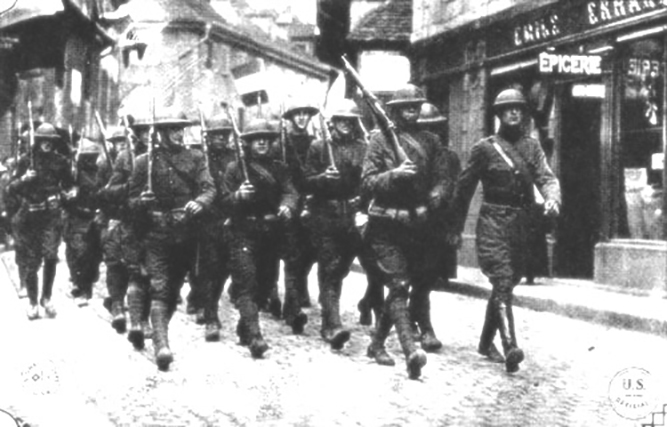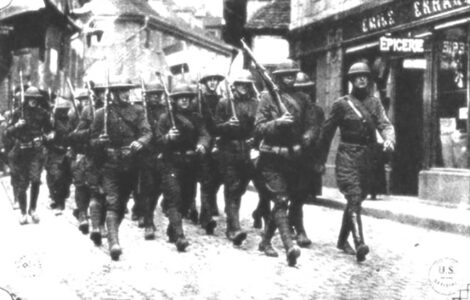Houghton County earned a reputation in the Great War
Copper Country sent troops to the Western Front

U.S. Army Signal Corps photograph 125TH Inf., 32D Division, passing through Massevaux, Alsace, 14 July 1918.
The United States entered World War I in the conflict’s final year. After the German Empire had announced an unrestricted submarine warfare, the United States declared war against the Central Powers on 6 April 1917. The war was already in its third year.
Among the divisions the U.S. sent to Europe was the newly reorganized 32nd Division, made up of national guard units from Michigan and Wisconsin. Michigan furnished 8,000 troops of all arms, while Wisconsin furnished approximately 15,000.
The 32nd Division was composed of two brigades, the 63rd and the 64th. The 63rd Infantry Brigade, consisting of the 125th and 126th Infantry Regiments, were formed with Michigan National Guard units. The 125th was comprised of men from the eastern or Detroit area while the 126th was from the western side of the state. The 64th Brigade comprised Wisconsin National Guard units.
The 63rd Brigade included Company G, 33rd Michigan Infantry Regiment, comprised of troops from Houghton and the 107th Engineer Regiment, including Company A, from Calumet, and Companies B and C, from Houghton. The 32nd Division arrived on the Western Front in February 1918 and was the sixth U.S. division to join the American Expeditionary Force under Gen. John J. Pershing.
Over the next six months, the division was under constant fire, with only 10 days of rest. The division took a leading role in three important offensives, fighting on five fronts, and had more than 14,000 casualties, captured more than 2,000 prisoners and never yielded ground to the enemy.
Moving into Alsace in May 1918, the 32nd advanced 12 miles in seven days. During the Battle of Marne, they captured Fismes.
The only American unit in French Gen. Charles Mangin’s famous 10th French Army, the 32nd fought between the Moroccans and the Foreign Legion, two of the best divisions in the French army in the Battle of Oise-Battle of Aisne offensive.
The 10th Army took Juvigny. In the five-day battle against five German divisions, the 32nd recorded 2,848 casualties.
Moving out of their trenches, the division fought continuously for 20 days during the Meuse-Argonne Offensive and was the vanguard of the Third U.S. Army.
The Germans, in their trenches, had orders to hold the line at all costs. On Oct. 14 at 5:30 a.m., the division broke the lines and took the trenches forming the Hindenburg Line, then moved on to the last German stronghold at Kriemhilde Stellung, where they reached the Meuse River.
The 32nd was the first Allied Army unit to penetrate the Hindenburg Line. They then captured Côte Dame de Marie, the key to all the defenses in the area.
Over the next five days the division continued to advance while under nearly constant machine gun and artillery fire. The 32nd Division defeated 11 German divisions in the Argonne fighting, including the fearsome Prussian Guards and the German Army’s 28th Division, known as Kaiser’s Own.
The offensive cost the division 5,950 casualties.
The 32nd fought in three major offensives, engaging and defeating 23 German divisions. They took 2,153 prisoners and gained 20 miles, pushing back every German counterattack.
During the drive to capture Fismes, the division successfully attacked over open ground at great cost
The 32nd Division was one of the best fighting divisions in Europe, which is evident in its combat records:
The 32nd Division, however, paid heavily for its glory. More than 2,200 soldiers in the division were killed and 11,000 were wounded within a few months in 1918.
The authorized strength of the 3rd battalion was 20 officers and 1,000 men, but by Aug. 4 it had only 12 officers and 350 men on the line.
More than 800 officers and men decorated by American, French and Belgian governments, including 275 Distinguished Service Crosses. The colors of all four Infantry Regiments, three Artillery Regiments and three Machine Gun Battalions wear the Croix de Guerre With Palm of the Republic of France, while every flag and standard in the Division has four American battle bands.
The units of the 32D Division were the only ones in the National Guard bestowed with France’s highest order of the Croix de Guerre with Palm during WWI. Insignia is a Red Arrow, signifying that the Division shot through every line the enemy put before it. Awarded the nom-de-guerre of Les Terribles by the French. Romagne-sous-Montfaucon, in the Lorraine District of France, is home to the Meuse-Argonne American Cemetery, which is about 25 miles northwest of Verdun. It contains the graves of 14,246 American soldiers, making it the largest of all the World War I American cemeteries. Among those buried there are soldiers from Michigan. They lost their lives in the Meuse-Argonne Offensive of 1918 and lay now in an area of approximately 130 acres. The Meuse-Argonne American Cemetery is, of course, not the only cemetery dedicated to American soldiers who fell in the now nearly forgotten war, but it is the largest.




